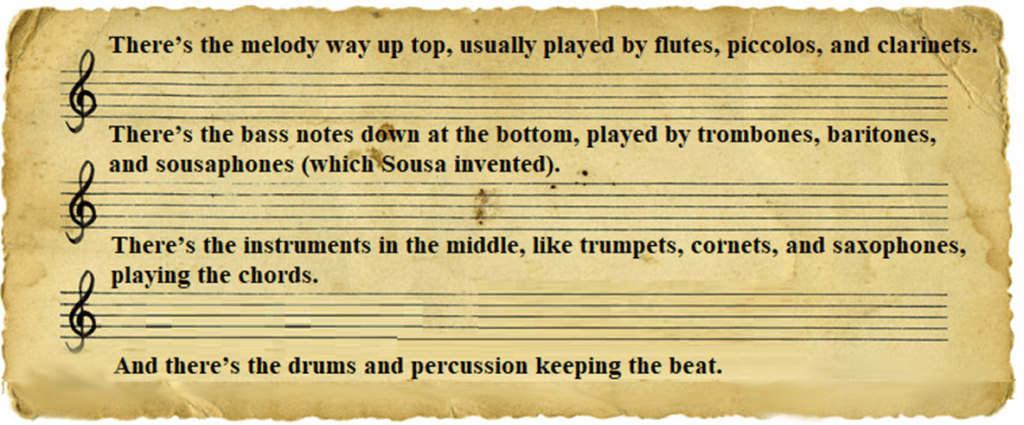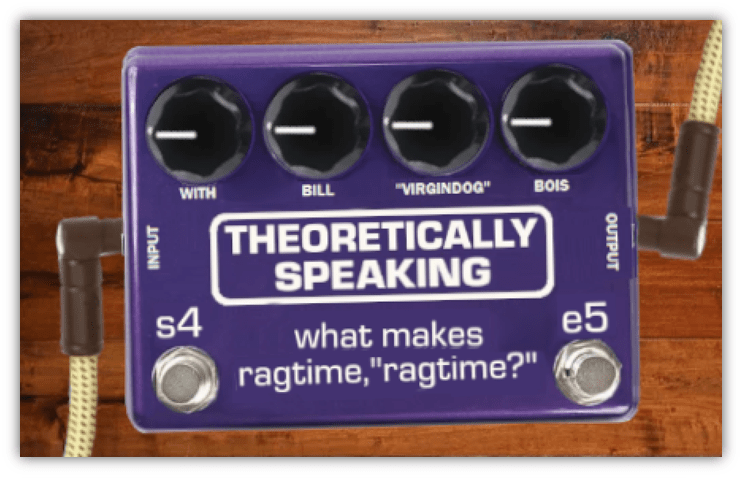I haven’t done an article on marches (yet.)
But you no doubt know the name John Phillip Sousa.

“Drop down and give me 20.”
Even if you don’t, you know his music.
He wrote “The Washington Post,” and “Stars and Stripes Forever,”

And, “The Liberty Bell,” which was used as the Monty Python’s Flying Circus theme.
They chose “The Liberty Bell” because it was in the public domain, and therefore cost them nothing to use.

That’s the same reason Warner Bros. cartoons used so much classical music.
Anyway, Sousa wrote operettas and suites and humoresques and plain old songs.
But he’s mostly known for his marches with patriotic titles. He was around just after the American Civil War, so the country needed all the patriotism it could get as it tried to pull itself back together.
The problem with marches is they require a marching band.
Trying to get 30-plus musicians to show up at the same place at the same time, and pay them all, is a feat in and of itself. And you can’t squeeze them into the corner of your midwestern saloon. Trust me, it’s hard enough with a punk trio.

“Malcolm? You’re fired.”
Saloons could afford a piano and someone to play it.
But the question is: how can one musician compete with a huge ensemble?
Even though the marching band has dozens of players, the instruments can be divided into four parts:

So, if the piano player can play the melody with his right hand and keep a steady beat, that’s two of the four parts taken care of. But it means that the left hand has to play both the bass part and the chords.
If you look up the word “stride,” you’ll get a bunch of definitions, both verbs and nouns. Usually, the last noun refers to “stride piano.“ Here’s what I found on dictionary.com:

Stride piano did indeed become its own thing in the 1920s.
The technique was called “stride bass” in the ragtime days, and the stride genre is the link between ragtime and jazz
What the left hand does in ragtime and stride is play a single bass note on the first beat of the measure, then “stride” up the keyboard an octave and play a chord on the second beat, then stride back down to play another bass note on the third beat, then back up to play a chord on the fourth beat.

That alone takes tremendous concentration, and even more so because the right hand is playing the melody.
Plus, the left hand has to keep a steady beat like a marching band, and the right hand plays with syncopation. That is, the left hand is exactly on the beat and the right hand is slightly off. Or a lot off, as the case may be.
That’s how ragtime got its name. Its time is ragged.
I’m glad I’m a bass player and only have to worry about one note at a time. What the ragtime piano players did is astoundingly difficult. They were masters of their craft. Playing in cheap saloons.

Chestnut Valley was an African-American section of St. Louis, MO, that had a number of bars and brothels and other businesses.
The bars and brothels needed entertainment and hired piano players.

A businessman named Tom Turpin opened a saloon there in 1897. He also published sheet music, including his own song “Harlem Rag.”
It didn’t yet have the secondary rag trick but it has the same left hand stride of the ragtime about to come.
Other piano players in Chestnut Valley heard “Harlem Rag” and used it as inspiration for their new compositions.
In Texas following the Civil War, newly freed African-Americans had trouble finding work that paid more than subsistence wages. One of these people, a young man named Scott Joplin from Texarkana, didn’t like low pay manual labor, moved to Sedalia, Missouri and made a living teaching piano. He also wrote instrumental pieces.
A local music publisher named John Stark heard Joplin play his composition “Maple Leaf Rag” in 1899 and signed him to a publishing deal for $50 plus a royalty of a penny per copy of sheet music sold. Stark set about promoting the work. It didn’t happen overnight but they sold a million copies by 1914.
“Maple Leaf Rag” was successful enough for both men to move to St. Louis and eventually New York City. Stark became the biggest publisher of ragtime sheet music. Joplin composed rags and operas for the rest of his, sadly, short life.
Ragtime songs have been arranged for other instruments, but it’s really piano music.
Having said that, its ancestors are the fast picking banjo music from Appalachia and the South, the jigs and fiddle music of British immigrants, and something called the cakewalk.

The cakewalk started as slaves making fun of their masters’ stiff, formal, dancing.
The slaves’ satirical, exaggerated, movements struck everyone as funny, including the whites, and many masters held competitions.
The prize for the best or funniest dance was a cake, hence the name cakewalk.
Cakewalk music was played by ensembles, not just piano, but ragtime took that joyous verve for its own. It also took the speed, dexterity, and happiness of banjo and fiddle music.
The big three names in ragtime are known as the Big Three.

Scott Joplin is of course the most familiar, and the other two star composers were Joseph Lamb and James Scott.
While ragtime was centered around black musicians in Missouri, Joseph Lamb was a white piano player in New Jersey. He loved Joplin’s music and began writing his own rags. Joplin heard and liked Lamb’s music so much that he introduced him to Stark, and Stark became Lamb’s publisher. A couple of Lamb’s more popular tunes are “Topliner Rag” and “Champagne Rag.”
His work had a duality to it. He sometimes wrote in the cakewalk style, upbeat and joyful. And he sometimes wrote with a darker, minor key, ambiance. At the end of the 1910s, Joplin died, Lamb’s wife died, and ragtime inevitably faded out of popularity.

Lamb gave up music and became an accountant.
He composed for his own pleasure only and didn’t publish his new songs until he released an album called “Joseph Lamb: A Study in Classic Ragtime” in 1960.
He died the following year at the age of 72.
James Scott had a similar relationship with Joplin. He was the son of former slaves and found work as a song plugger for a music publisher in Carthage, Missouri. If you went into a music store and wanted to hear a song before you bought its sheet music, you’d bring it to the song plugger. He’d put the sheet music on the piano and play it for you, much like we would listen to CDs in stores before buying them in the 1990s.
Scott’s employer published four of his compositions but overall business wasn’t good and the shop closed.

Scott went to St. Louis with the intent of playing his songs for Joplin, and that’s exactly what happened.
Joplin liked the tunes and, again, introduced him to Stark who gave Scott a publishing deal.
His “Frogs Legs Rag” was a huge hit, selling more copies than anything else Stark published except “Maple Leaf Rag.”
He married in 1914 and moved to Kansas City where he took up teaching and working as an arranger in theater. When ragtime lost popularity, he played organ during silent movies, but talkies came along and ruined him financially. His wife died young, he lost his arranging work, and died destitute at the age of 52.
Joplin himself died at 48. He had been admitted to a New York City mental institution with syphilitic dementia. It was 1917, and many consider his passing to be the end of ragtime.
Some critics at the time said that ragtime was “lowbrow” and “musical poison.” A few folks, as always, said it would corrupt the minds of young people. These critics were, of course, big fat doody heads. They clearly didn’t understand the difficulty or intricacies of the genre.

It’s important to mention here that there’s not much improvisation in ragtime. You play what’s written on the page.
There’s no embellishing or otherwise disrespecting the composer’s wishes. Ragtime has that in common with classical music, its predecessor, but what little improvisation occurs is, like in baroque, on repeated passages later in the pieces. Why play exactly what you played before when you can throw in a little flair?
Not only is composing three parts for two hands difficult, it’s really hard to play, too.
Playing ragtime is as challenging as playing baroque or classical. Playing Bach or Chopin or Lizst takes as much talent and dedication as playing Joplin or Lamb or Scott.
Some classical composers of the early 20th Century recognized ragtime’s value and the Big 3’s genius. Debussy, Dvorak, and Satie each incorporated ragtime elements into their work. Debussy’s “Golliwog’s Cakewalk” is a nice blend of Joplin’s playfulness, Lamb’s atmosphere, and Debussy’s subtlety.
There was a revival of ragtime in the 1950s, which may have convinced Lamb to put out his album of unreleased compositions, and a bigger revival in the 1970s.

That one was in part prompted by an album called “Piano Rags by Scott Joplin” by Joshua Rifkin.
It was nominated for two Grammy Awards.
Its popularity may have led to ragtime being featured in a 1973 movie called “The Sting.”
Even though the story takes place in 1936, two decades after ragtime. It used Joplin’s “The Entertainer” as its main theme.

The movie won ten Oscars including Best Picture and Best Scoring: Original Song Score and Adaptation or Scoring: Adaptation.
Half of the soundtrack album is Joplin tunes.
Not only did ragtime sell a lot of sheet music in its time, it sold a lot of pianos. People had them in their homes even if they couldn’t play any of the Big 3. They tried. Some became pretty good.

It doesn’t matter if they got good or not. Music in the home brings families together, though not when everyone’s wearing their own earbuds.
Ragtime is a truly American genre, coming from smack dab in the middle of the country at that time.
It took the technical aspects of classical piano and the arrangements of patriotic marches, and produced something that would influence other American genres, like jazz, blues, and rock & roll, for the next hundred years.
In the words of the great bluesman Taj Mahal:
“I’m feeling so much better, I could cakewalk into town.”
Suggested Listening – Full YouTube Playlist

Harlem Rag
Tom Turpin
1897

Mississippi Rag
William Krell
1897

Cake Walk In The Sky
Ben Haney
1899

Maple Leaf Rag -1899
The Entertainer –1902
Scott Joplin

Frogs Legs Rag
James Scott
1906

Dill Pickles Rag
Charles L. Johnson
1906

Sensation Rag
Joseph Lamb
1908

The Thriller!
May Aufderheide
1909

Golliwog’s Cakewalk
Claude Debussy
1913

Nola
Felix Arndt
1915

Carolina Shout
James P. Johnson
1921

Coaxing The Piano
Zez Confrey
1922
Let the author know that you liked their article with a “Green Thumb” upvote!





Great write-up, Bill.
Ragtime is perhaps the first great American music, at least as far as national phenomena go.
I don’t know if I mentioned this before, but Beethoven’s Piano Sonata 32 from 1822 got pretty darn close to the sound of ragtime. It certainly features some heavy syncopation. What sets ragtime apart from that work was the anchoring of the syncopated rhythm to a steady bass rhythm, as you mentioned. The fusion of those two disparate components made for a magical new sound: hypnotic, energetic, freewheeling, full of life.
The joyful power of the music is all the more exceptional given its roots in slaveholding households. The slaves dancing to imitate and exaggerate the graceful moves of the white nobility actually reminds me of a DIY phenomenon that emerged decades later: the Ballroom scene vogueing of the 1980s. Except that at cakewalks, the slaves’ imitative dances had to please their captors as well. It must have taken great skill and effort for the cakewalk musicians to radiate confidence, positivity, and fun given the air of menace that surely haunted those events, just as it must have taken the dancers great skill and effort to look so effortless in their grace. The fact that the word “cakewalk” has since come to mean “extremely easy; requiring little effort” is extremely unfortunate. It perhaps reveals a penchant among White communities for taking the surface qualities of Black entertainment culture for granted without looking at the more poignant undertones.
There’s also the unfortunate pathway in which cakewalk music caught on as a musical phenomenon across the country, to eventually be dubbed ragtime. Radio helped later on, but originally it was due to Black musicians working the minstrel shows, engaging in self-mockery to make a living. One such entertainer was Ernest Hogan, who made the very first recording of cakewalk music featuring that prominent ragged time in 1895. It’s a travesty that the first record of its kind had to be a song called “All C—ns Look Alike To Me,” but it was very much a product of its time.
You’re right though, regardless of how it was treated at the time, this is sophisticated music. Scott Joplin rightfully thought himself a composer in the classical tradition, just with a wild new approach. He even composed an opera, “Treemonisha,” in 1911. It has some ragtime music to it, just as some stylistic accents here and there, but it’s what we would consider a proper opera. I’m not a huge fan of opera, but I found watching the live performance quite compelling:
https://www.youtube.com/watch?v=OLyh2jCvzG0
Another fantastic read Bill, but as you discussed the cakewalk I thought back to Childish Gambino’s “This is America”, which is in the running for favorite song since 2010. I’m very curious to see what Tom gives it.
I stopped reading when I got to the cakewalk section and looked up the cover(t) art for the House of Freaks third album. I’m truly seeing it for the first time. I didn’t know there was synergy between song and visual. I don’t think the label knew either.
And then I continued reading.
Finally, I have a reason to give a shout-out to House of Freaks. I think they’re one of those bands whose potential popularity was curbed by the Seattle sound.
Listened to “This is America” for the first time, thegue. It’s great.
Great article, Mr. Bois.
I wonder how the word turned into slang for “easy”?
It’s a sports metaphor that I haven’t heard in quite awhile.
The recording software I use at home is by a company called Cakewalk.
Hopefully you saw the video for “This Is America.” It’s phenomenal.
I know Donald Glover as an actor. I don’t know why I thought his alter-ego was comedic, like Jordan Peele, when he was a part of Key and Peele. I was startled.
Thanks for this info on cakewalk. I knew a little bit about it, learned more in researching ragtime, and even more just now. Why aren’t we taught about in school?
Never mind. I know.
The pure musical joy that came out of slavery astounds me.
Same reason we didn’t learn about the Tulsa race massacre, I fear.
And so many other topics that have been ignored for centuries. And now, there are laws being passed that make it actually illegal to teach about much of it.
I am always impressed by the spiritual music that came from slavery. As you say, joy, along with hope and faith coming from just about the worst circumstances imaginable.
I don’t remember my introduction to ragtime music as a commercial endeavor. It might have been “The Sting”, or it might have been the song below. I remember the theme from “The Sting” being on the radio, but I’m not really sure that I recognized what genre it was.
I do remember my first (but not last) piano teacher playing what he called “rag” music. He was a self-taught player, a World War II veteran who had landed on Normandy Beach, and, while I don’t use the word lightly, a genius. I think that some of his rags were self-composed, but no one ever wrote them down, and they died with him many years ago.
I don’t have any of his music, but this Billy Joel song reminded me of him when I first heard it as a teenager.
https://www.youtube.com/watch?v=VWH9iwtl9Q4
Forgot about the Joel tune. It’s a good’un.
genuflect, genuflect, genuflect…
https://www.youtube.com/watch?v=3f72CTDe4-0
Gee, it’s good to see ya.
I can’t say I knew much about ragtime other than an awareness of Scott Joplin through the Sting and the use of Black and White Rag as the theme tune to Pot Black, a snooker tournament shown on the BBC in the 1980s – not that I had any idea what that tune was at the time.
At the end of last year I read Bob Stanley’s book Let’s Do It which covers the birth of pop from the end of the 19th century to the beginnings of rock and pop. Bob whose other job is member of St Etienne and who in the acknowledgements to his book credits a certain Tom Breihan.
There’s a chapter on ragtime, leading with Scott Joplin and drawing in Sousa, Lamb, Scott, cakewalk and stride as well – great minds and all that. Bob starts his account with Ben Harney noting that in 1896 on the sheet music for ‘You’ve Been A Good Old Wagon But You Done Broke Down’ Harney is credited as the ‘Original Introducer to the Stage of the Now Popular “Rag Time” in Ethiopian Song’. He has Harney moving to New York in the same year, playing Rag time piano at the Weber and Fields Music Hall and Metropolitan Opera House, them in 1897 publishing a Rag Time Instructor.
Can’t say I’d ever heard of him before but he’s noted as the highest paid popular musician in America until Al Jolson. Mass popularity is no guarantee that you’ll be well remembered 100 years down the line.
It’s a jolt to see the title of Claude Debussy’s composition. Golliwog’s have a dubious history over here. They were hugely popular here for much of the 20th century, even used to sell jam for decades but the term and the dolls became increasingly toxic for their racist overtones. They’re now a depressing symbol of the culture wars with defenders of the dolls and the term using all sorts of spurious claims around their origins to justify their existence. I guess Debussy’s use of the term shows how normal it was for the time.
Yeah, I was gonna mention that about Debussy. It’s almost certainly due to cakewalk music gaining popularity through minstrel shows and artists like Ernest Hogan…who did state that he greatly regretted his decision to abase himself for others’ amusement. But to be fair to Hogan, he needed to make a buck in a culture that just barely acknowledged his agency, and with great resistance.
I didn’t know if it had the same hold on the nations psyche as it does over here. Just in the last couple of months there’s been a huge storm over a pub that had the dolls on display. Ended up with police raiding the pub following allegations of a hate crime, media mayhem, an unrepentant owner and in the last week the pub forced to close as the breweries refused to do business with it anymore due its new found notoriety.
Dialogue from Ghost World (definitely a Canon contender):
Seymour : That was great music, huh?
Red-Haired Girl – Blues Club : Yeah. I just love blues.
Seymour : Actually, technically, um, what he was mostly playing would be more accurately classified in the ragtime idiom. Although, of course, not in the strictest sense of the classical ragtime piano music, uh, like that of Scott Joplin or – Joseph Lamb. Authentic blues has a – has a more conventional 12-bar structure in its stanzas.
Red-Haired Girl – Blues Club : Oh. If you like authentic blues, you really gotta check out Blueshammer. They’re so great.
All Seymour had to say was I like the blues, too. I like what you did with your hair. And despite being so lonely, the guy was such a purist, he couldn’t bring himself to pretending that he liked Blueshammer.
This was fascinating VDog. I had no idea Ragtime stemmed from essentially streamlining marches. Ragtime is unbelievably intimidating not just to play, but even just to listen. But boy, is it a treat to hear. Tremendous respect to those Big Three for having that kind of incredible talent.
I didn’t get to say this but Joplin had some experience in choirs, so he knew about the various parts (bass, baritone, tenor, alto, soprano, etc.) from there. He probably got incorporated that into his piano music, too.
There’s gotta be one or two songs in this short that qualify:
https://youtu.be/bkjsN-J27aU
Two different artists took “Hello, Ma Baby” to #1 in the 1890s (according to Joel Whitburn).
But the frog did it best.
I’m getting caught up after my travel last week. I love this entry, and I look forward to listening to all of your suggested songs.
Stride piano takes some crazy talent to play. And often those players were singing lyrics on top of it all. How did they do it?
And I appreciated your comments on pianos. They were crazy popular back in the opening decades of the 20th century. Many of the pianos that you can find for free on craigslist daily in any good size city are probably from this very era 100+ years ago.